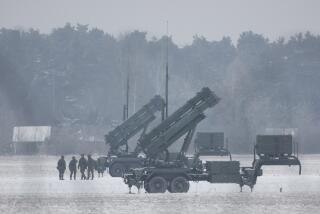Cost of Iraq, Afghanistan wars will keep mounting

- Share via
The wars in Iraq and Afghanistan will ultimately cost between $4 trillion and $6 trillion, with medical care and disability benefits weighing heavily for decades to come, according to a new analysis.
The bill to taxpayers so far has been $2 trillion, plus $260 billion in interest on the resulting debt. By comparison, the current federal budget is $3.8 trillion.
The costs of the wars will continue to mount, said the study’s author, Linda Bilmes, a public policy expert at Harvard University.
The largest future expenses will be medical care and disability benefits for veterans, Bilmes predicted. “The big, big cost comes 30 or 40 years out,” she said.
The wars, taken together, will be the most expensive in U.S. history — and not just because of their duration. The government has greatly expanded the services available to veterans and military personnel over the last decade. Compared with past conflicts, a far greater proportion of returning service members are seeking medical care and benefits.
Of the 1.56 million troops that have been discharged, more than half have received treatment at Veterans Affairs facilities and filed claims for lifetime disability payments, the study found.
Many suffered injuries that would have been fatal a generation ago. Others have post-traumatic stress disorder or other mental health problems that in previous wars often went undiagnosed and untreated.
The government has already spent $134 billion on medical care and disability benefits for veterans returning from Iraq and Afghanistan. Bilmes estimated that in coming decades these benefits would cost an additional $836 billion.
Estimating the long-term costs of the wars is an exercise in uncertainty. Most studies have looked at the problem in pieces, and usually no more than a decade into the future.
In 2010, the Congressional Budget Office examined the potential impact on the VA and predicted that in 2020, the wars in Iraq and Afghanistan would account for 16% of veterans in the system and 8% of a $69-billion healthcare budget. The majority of VA users would still be older veterans of earlier wars, and conditions such as diabetes would be driving the costs.
Bilmes looked much farther into the future. Her analysis included a wide range of direct and indirect costs, including replacement of the equipment used in the wars, continued funding of a U.S. diplomatic presence in Iraq and Afghanistan, the rapid expansion of the military’s healthcare system and the economic impact on families of the injured and the dead.
She said that the high cost of caring for service members and veterans could ultimately lead to a smaller fighting force and greater investment in unmanned weapons, robotics and other technology.
“It’s going to force the Pentagon into making some very difficult trade-offs,” she said.
More to Read
Sign up for Essential California
The most important California stories and recommendations in your inbox every morning.
You may occasionally receive promotional content from the Los Angeles Times.














